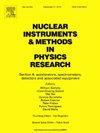Gain suppression in LGAD detectors under focused and defocused femtosecond laser beam
IF 1.5
3区 物理与天体物理
Q3 INSTRUMENTS & INSTRUMENTATION
Nuclear Instruments & Methods in Physics Research Section A-accelerators Spectrometers Detectors and Associated Equipment
Pub Date : 2025-07-17
DOI:10.1016/j.nima.2025.170844
引用次数: 0
Abstract
Low Gain Avalanche Diodes (LGADs) are particle detectors with a moderate gain ( 50) optimized for high energy physics experiments. Gain in these sensors is controlled by bias voltage but it depends also on the other factors such as temperature and charge density generated in the gain layer. When the laser pulses are used to study LGADs, charge density strongly depends on the beam parameters. The same laser intensity can induce different charge density across the gain layer if the focusing parameters vary. It is known that higher ionization densities cause reduction of the gain and this effect has been already investigated. Here, we present extension of the previous gain suppression studies investigating not only spatial, but also temporal distribution of the laser pulses. In addition, we demonstrate gain suppression effect at two different wavelengths commonly used in characterization of the silicon detectors.
聚焦和散焦飞秒激光束下LGAD探测器的增益抑制
低增益雪崩二极管(LGADs)是一种具有中等增益(<;50)高能物理实验优化。这些传感器中的增益由偏置电压控制,但也取决于增益层中产生的温度和电荷密度等其他因素。当激光脉冲用于研究低电荷耦合器件时,电荷密度很大程度上取决于光束参数。当聚焦参数不同时,相同的激光强度会在增益层上产生不同的电荷密度。众所周知,较高的电离密度会导致增益的降低,这种效应已经被研究过了。在此,我们对先前的增益抑制研究进行了扩展,不仅研究了激光脉冲的空间分布,而且研究了激光脉冲的时间分布。此外,我们还演示了在硅探测器特性中常用的两种不同波长下的增益抑制效应。
本文章由计算机程序翻译,如有差异,请以英文原文为准。
求助全文
约1分钟内获得全文
求助全文
来源期刊
CiteScore
3.20
自引率
21.40%
发文量
787
审稿时长
1 months
期刊介绍:
Section A of Nuclear Instruments and Methods in Physics Research publishes papers on design, manufacturing and performance of scientific instruments with an emphasis on large scale facilities. This includes the development of particle accelerators, ion sources, beam transport systems and target arrangements as well as the use of secondary phenomena such as synchrotron radiation and free electron lasers. It also includes all types of instrumentation for the detection and spectrometry of radiations from high energy processes and nuclear decays, as well as instrumentation for experiments at nuclear reactors. Specialized electronics for nuclear and other types of spectrometry as well as computerization of measurements and control systems in this area also find their place in the A section.
Theoretical as well as experimental papers are accepted.

 求助内容:
求助内容: 应助结果提醒方式:
应助结果提醒方式:


